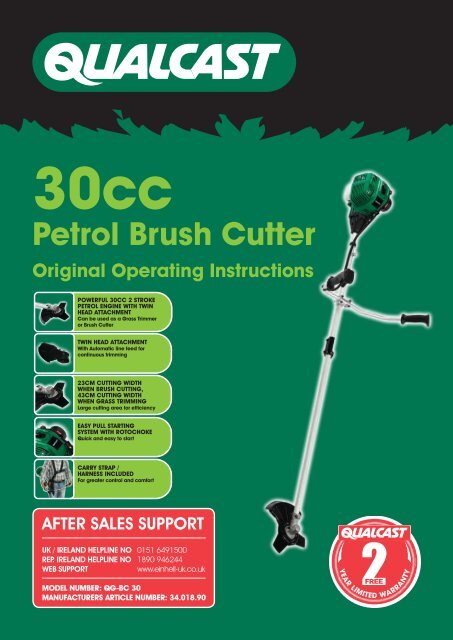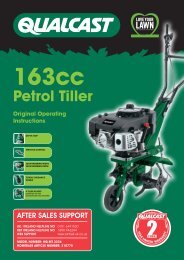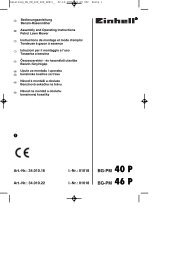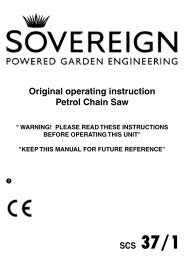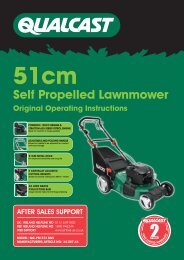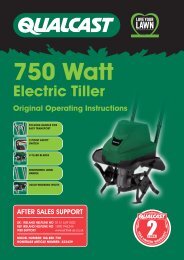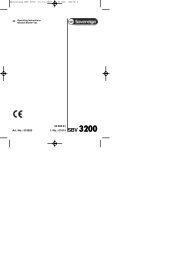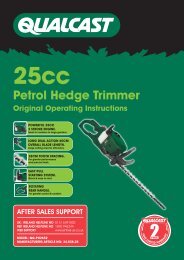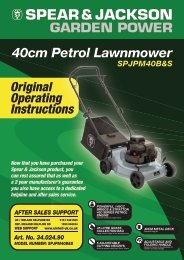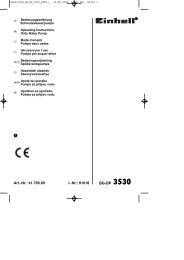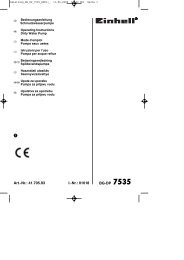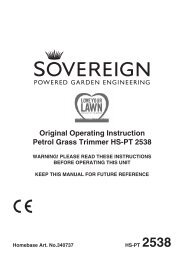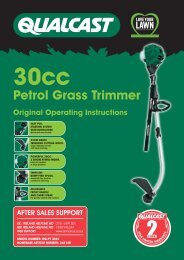You also want an ePaper? Increase the reach of your titles
YUMPU automatically turns print PDFs into web optimized ePapers that Google loves.
Safety Information1. Read the instructions with due care. Familiarizeyourself with the settings and proper operationof the machine.2. Never allow children or other persons who arenot familiar with the operating instructions touse the petrol grass trimmer.3. Never mow in the direct vicinity of persons -especially children - or animals.Warning: Maintain a safety distance of 15m.If approached, switch off the applianceimmediately. Always keep in mind that themachine operator or user is responsible foraccidents involving other persons and/or theirproperty.Preliminary measures1. Always wear sturdy, non-slip footwear and longtrousers when operating the machine. Neveroperate the machine barefoot or in sandals.2. Check the grounds on which the machine willbe used and remove all objects that couldbe caught up and violently flung out.3.Warning: <strong>Petrol</strong> is highly flammable!• Only store petrol in containers designed tohold petroleum-based liquids.• Only refuel out in the open and do not smokeduring the refueling process.• Always refuel before starting the engine.Do not open fuel tank cap and do not refuelwhen the engine is running or when the brushcutter is hot.• If petrol has overflowed, do not under anycircumstances attempt to start the engine.Instead, remove the machine from the affectedarea. Avoid starting the engine until the petrolfumes have completely evaporated.• For safety reasons, the petrol tank and othertank closures must be replaced if they aredamaged.4. Replace defective exhausts.5. Before using the petrol brush cutter, visuallyinspect it to ensure that the mounting boltsand the entire cutting apparatus are in goodworking order (i.e. not worn out or damaged).To prevent any imbalance, replace worn outblades or damaged mounting bolts as a setonly (if applicable).Handling1. Wear close fitting, tough work clothing thatwill provide protection, such as long slacksor trousers, protective footware, heavy dutywork gloves, hard hat, a safety face shield,or safety glasses for eye protection and agood grade of ear defenders or other soundbarriers for hearing protection.2. Store in a safe place. Open fuel cap slowly torelease any pressure which may have formedin fuel tank. To prevent a fire hazard, moveat least 10 feet (3 meters) from fueling areabefore starting.3. Turn unit off before setting it down.4. Always hold unit firmly with both hands,the thumb and fingers encircling the handles.5. Keep all screws and fasteners tight. Never operateyour equipment when it is improperly adjusted ornot completely and securely assembled.6. Keep handles dry, clean and free of fuel mixture.7. Keep the cutting head as close to ground aspractical. Avoid hitting small objects with theline spool. When cutting on a slope, standbelow stringhead. NEVER cut or trim on a hillor slope, etc. if there is the slightest chance ofslipping, sliding or losing firm footing.8. Check the area you will be trimming for debristhat may be struck or thrown during operation.9. Keep all parts of your body and clothing awayfrom the cutting head when starting or runningengine. Before starting the engine, make surethe cutting head will not come in contactwith any obstructions.10. Stop the engine before examining cutting line.11. Store equipment away from possibleflammable materials, such as gas-poweredwater heaters, clothes dryers, or oil-firedfurnaces, portable heaters, etc.12. Always keep the safety guard, the cuttinghead, and engine free of debris build-up.13. Operation of equipment should always berestricted to mature and properly instructedindividuals.14. If unfamiliar with trimming techniques, practicethe procedures with engine in “OFF” position.15. Always clear work area of debris such ascans, bottles, rocks, etc. Striking objectscan cause serious injury to the operator orbystanders and also damage equipment.If an object is hit accidentally, turn the04Helpline No. UK 0151 649 1500 / IRE 189 094 6244
engine off immediately and examinethe equipment. Never operate unit withdamaged or defective equipment.16. Always trim or cut at high engine speeds.Do not run engine slowly at start or duringtrimming operations.17. Do not use equipment for purposes otherthan trimming or mowing weeds.18. Never raise the cutting head above kneeheight during operation.19. Do not operate unit with other people oranimals in the immediate vicinity. Allow aminimum of 50 feet (15 meters) betweenoperator and other people and animalswhen trimming or mowing. Allow a distanceof 100 feet (30 meters) between operatorand other people and animals whenoperating the petrol grass trimmer.20. If operating on a slope, stand below thecutting attachment. Do not operate on aslope or hilly incline if there is the slightestchance of slipping or losing your footing.Additional instructions1. DO NOT USE ANY OTHER FUEL other than thatrecommended in your manual. Always followinstructions in the Fuel and Oil section of thismanual. Never use petrol unless it is properlymixed with 2-stroke engine oil. Permanentdamage to engine will result, voidingmanufacturer’s warranty.2. DO NOT SMOKE while refueling or operatingequipment.3. DO NOT OPERATE UNIT WITHOUT AN EXHAUSTand properly installed exhaust shield.4. DO NOT TOUCH or let your hands or bodycome in contact with the exhaust. Hold unitwith thumbs and fingers encircling the handles.5. DO NOT OPERATE UNIT IN AWKWARDPOSITIONS, off balance, outstretched arms,or one-handed. Always use two hands whenoperating unit with thumbs and fingersencircling the handles.6. DO NOT RAISE THE LINE SPOOL above groundlevel while unit is operating. Injury to operatorcould result.7. DO NOT USE UNIT FOR ANY PURPOSES OTHERthan trimming lawn or garden areas.8. DO NOT OPERATE UNIT FOR PROLONGEDPERIODS. Rest periodically.9. DO NOT OPERATE UNIT WHILE UNDER THEINFLUENCE OF ALCOHOL OR DRUGS.10. DO NOT OPERATE UNIT UNLESS SAFETY GUARDIS INSTALLED AND IN GOOD CONDITION.11. DO NOT ADD, REMOVE OR ALTER ANYCOMPONENTS OF THIS PRODUCT. Doing socould cause personal injury and/or damagethe unit voiding the warranty.12. DO NOT operate your unit near or aroundflammable liquids or gases whether in or outof doors. An explosion and/or fire may result.13. DO NOT USE ANY OTHER CUTTING TOOLS.For your own safety only use the accessoriesand additional equipment specifiedin the operating manual. The use oftools or accessories other than thoserecommended in this operating manualmay place you in danger of personal injury.Safety when handling the blade1. FOLLOW ALL WARNINGS and instructions forusing the machine and for installing the blade.2. The blade may suddenly jump away out ofcontrol if it comes up against objects whichit cannot cut through. This may result inSerious injury. Keep onlookers and animals atleast 15 m away from where you are working. Ifthe machine strikes a foreign body, stop theengine immediately and bring the blade to astandstill. Check the blade for signs of damage.Always replace the blade if it is bent or damaged.3. THE BLADE WILL THROW UP OBJECTS ATHIGH SPEED: This may cause injuries to eyes,face and legs. Always wear eye, face and legprotection. Remove all objects from the workingarea before using the blade. Keep other peopleand animals at least 15 m away from themachine in all directions.4. Check your machine and other equipmentcarefully for signs of damage. Do not use themachine unless all the blade mountings havebeen installed correctly.5. THE BLADE WILL SLOW DOWN AND STOP IFYOU RELEASE THE THROTTLE VALVE.While it is slowing down, the blade can stillcause injury to you or onlookers. Before you carryout any work on the blade, switch off the engineand make sure that the blade has stopped.6. DANGER ZONE WITH A DIAMETER OF 15METRES. Onlookers may suffer injuries. Keeponlookers and animals at least 15 m away fromwhere you are working.Helpline No. UK 0151 649 1500 / IRE 189 094 624405
A1215911161056131418781924B1317C2022212342302406Helpline No. UK 0151 649 1500 / IRE 189 094 6244
D1D225192426D325D41926D5D626CB19AHelpline No. UK 0151 649 1500 / IRE 189 094 624407
D7DE12E22729428E328E429F13108Helpline No. UK 0151 649 1500 / IRE 189 094 6244
F2F323F4F5F6G9Helpline No. UK 0151 649 1500 / IRE 189 094 624409
G1G2G3G4G5G610Helpline No. UK 0151 649 1500 / IRE 189 094 6244
HH1IJ1J2K1Helpline No. UK 0151 649 1500 / IRE 189 094 624411
K2M1M2M3M4M512Helpline No. UK 0151 649 1500 / IRE 189 094 6244
O1O2Important!When using the equipment, safety precautionsmust be observed to avoid injuries anddamage.Please read the complete operatinginstructions and safety regulations with duecare. Keep this manual in a safe place, so thatthe information is available at all times. If yougive the equipment to any other person, handover these operating instructions and safetyregulations as well.We cannot accept any liability for damage oraccidents which arise due to a failure tofollow these instructions and the safetyinstructions.1. Safety informationCAUTION!Read all safety regulations and instructions.Any errors made in following the safetyregulations and instructions may result in anelectric shock, fire and/or serious injury.Keep all safety regulations and instructionsin a safe place for future use.Safety devicesWhen working with the blade the metal guardhood must be installed and when workingwith the cutting spool the plastic guard hoodmust also be installed to prevent objects beingthrown out by the machine. The integratedblade in the plastic guard hood automatically cutsthe line to the optimum length.2. Machine description and itemssupplied (Fig. A – C)1. Line Spool Assembly2. Guard for blade with screws3. Guard for cutting line with screws4. Blade5. Handle6. Engine switch “ON/OFF” (1/0)7. Throttle lever “release”8. Throttle lever9. Fastening eyelet10. Choke (swivelling)11. Starter cable12. Spark plug boot13. Air filter housing cover14. Fuel tank15. Housing for engine cooler and starter16. Fuel pump “primer”17. Carrying strap18. Connecting piece for long handle19. Long handle with drive shaft20. Fuel mixture bottle21. Spark plug wrench22. 2-stroke oil23. Locking bar24. Allen Key (size 4mm)25. Additional half-handle (LH)26. Additional half-handle (RH)27. LH Threaded nut28. Drive Collar29. Blade clamp collar30. Cable clip14Helpline No. UK 0151 649 1500 / IRE 189 094 6244r
3. Proper useThe machine is designed for cutting lawns andgrassed areas.Important. Due to the high risk of bodily injuryto the user, the brush cutter must not be used tocarry out the following work: to clean (suck up)dirt and debris off walkways, or to chop up treeor hedge clippings. Moreover, the brush cuttermay not be used to level out high areas such asmolehills. For safety reasons, the brush cutter maynot be used as a drive unit for other work tools ortoolkits of any kind.The machine is to be used only for its prescribedpurpose. Any other use is deemed to be a caseof misuse. The user / operator will be liable for anydamage or injuries of any kind caused as a resultof this. Please note that our equipment has notbeen designed for use in commercial, trade orindustrial applications. Our warranty will be voidedif the machine is used in commercial, trade orindustrial businesses or for equivalent purposes.4. Technical dataEngine type: 2-stroke engine, air-cooled,chrome cylinderEngine power (max.): 0.76 kW/1.03 hpDisplacement:29.7 ccIdle speed of engine:2900 rpmMax. engine speed:11000 rpmMax. twin line speed:8000 rpmMax. blade speed:11000rpmIgnition:ElectronicDrive:Centrifugal clutchWeight (with empty tank):7.5 kgLong handle length:135 cmCutting circle diameter of line: Ø 43 cmCutting blade diameter:Ø 23 cmCutting line length:5.0 mCutting line diameter:2.0 mmTank capacity:0.6 lSpark plug:Torch L8RTCVibration ahv rear handle: 9.319 m/s 2Uncertainty of vibration level: 3.7m/s 2LpA sound pressure level:92 dB (A)LWA sound power level:112 dB (A)Uncertainty sound level:1dBSound and vibration were measured inaccordance with EN ISO 27917, 10884/7916.5. Before starting the equipment5.1 Assembly5.1.1 Installing the additional handleInstall the additional handle (LH and RHhalves) as shown in Figures D1 - D4.Do not fully tighten the screws until you haveset the perfect working position with thecarrying strap. The additional handle halvesshould be aligned as shown in Figure A.5.1.2 Assembly of the long handle (Fig. D6 - D7)Remove the transport guard cap from thelower long handle. Slacken the star grip screw(Fig. D6/Item A) on the connecting pieceon the upper long handle (Fig. D6/Item B).Carefully slide the lower long handle (Fig. D6/Item C) into the connecting piece on theupper long handle.When doing so, take care to ensure thatthe drive shafts on the insides of the longhandles slide into each other (turn the spoolhead gently, if required) and that the lock onthe lower long handle (Fig. D7/Item D) latchessecurely in the connecting piece.Now retighten the star grip screw (Fig. D6/ItemA). To dismantle, proceed in reverse order.5.1.3 Fitting/Replacing the blade (Fig. E1-E4)- Fit the Blade Guard (Fig. E1/Item 2) to the bottomof the drive unit & secure with the 3 screws.- Fit the Drive Collar (Fig. E3/Item 28) over thesplines on the drive shaft. Line up the hole inthe collar with the ‘u’ shaped recess in the drivehousing (Fig. E1 & E3). Then fit the blade (Item 4)onto the shoulder of the collar. (The blade isreversible, so either way up, is O.K).- Fit the Blade Clamp Collar (Fig. E2/Item 29) on topof the blade, and then fit the LH Threaded nut(Fig. E2/Item 27), counter-clockwise until fingertight. Insert the locking Bar (Fig. C/Item 23) intothe hole in the Drive Collar & use the SparkPlug Wrench (Fig. C/Item 21) to tighten the nut.(Important, LH thread = rotate the part/spanner counter-clockwise to tighten andclockwise to loosen).- To remove the Blade, rotate the assembly untilthe hole in the Drive Collar lines up with the ‘u’shaped recess in the drive housing, beforeusing the tools and proceeding in the reverseHelpline No. UK 0151 649 1500 / IRE 189 094 624415
order to remove the blade.5.1.4 Installing the cutting line guard hoodImportant: The cutting line guard hood must befitted if you wish to work with the cutting line. Theguard hood for the cutting line must be installedusing the 3 screws as shown in Figures F1 - F3.A blade (Fig. F6/ Item A) on the underside of theguard hood automatically cuts the cutting lineto the optimum length. This is covered by a ‘u’shaped guard (Fig. F6/Item B).Remove the ‘u’ shaped guard before you startworking and replace it when you have finishedworking.5.1.5 Fitting / Replacing the line spoolLine up the hole in the collar with the ‘u’ shapedrecess in the drive housing, and use the lockingBar to secure the drive shaft, whist you fit the linespool assembly (Fig. F4/F5).Important: Left-hand thread! Rotate the spoolcounter-clockwise to tighten and clockwiseto loosen).5.3 Fuel and oilRecommended fuelsUse only a mixture of normal unleaded petroland special 2-stroke engine oil. Mix the fuelmixture as indicated on the fuel mixing table.Please note: Do not use a fuel mixture whichhas been kept for longer than 90 days.Please note: Do not use 2-stroke oil with arecommended mixing ration of 100:1.If inadequate lubrication causes enginedamage, the manufacturer’s enginewarranty will be voided.Please note: Only use containers designedand approved for the purpose to transportand store fuel. Pour the correct quantities ofpetrol and 2-stroke oil into the mixing bottle(Fig. C/Item 22 see scale printed on thebottle). Then shake the bottle well.5.4 Fuel mixture tableMixing procedure: 40 parts petrol to 1 part oil<strong>Petrol</strong>2-stroke oil1 litres 25 ml5 litres 125 mlTo dismantle, proceed in reverse order.5.2 Setting the cutting height (Fig. G1-G6)Fit the carrying strap.Hook the machine to the carrying belt (Fig.G5). Adjust the perfect working and cuttingposition using the various strap adjuster onthe carrying strap (Fig. G1 - G4). In order toestablish the optimum length of the carryingstrap, you should then make a few swingingmovements without starting the engine (Fig. G6).Please note: Always use the shoulder strapwhen using the machine. Attach the strap assoon as you have started the engine and theengine is running in idle mode. Switch off theengine before you take off the shoulder strap.Check the machine for the following eachtime before use:• That there are no leaks in the fuel system• That the cutting unit and all safety devicesare in perfect condition• That all screws are securely fastened6. OperationImportant. A blade (Fig. F6/ Item A) on theunderside of the safety guard automaticallycuts the cutting line to the optimum length.6.1 Starting the engine when coldFill the tank with the required amount of oil/petrol mix. See “Fuel and oil”.1. Set the machine down on a hard, levelsurface.2. Set the choke position (Fig. A/Item 10) to „ “.3. Press the fuel pump (primer) (Fig H/Item 16)10 times.4. Switch the ON/OFF switch (Fig. A/Item 6) to “I”.5. Hold the machine firmly in position with onehand.6. With the other hand pull out the startercable (Fig. A/Item 11) until you feel it startsto resist. Then tug sharply on the startercable 10 times.16Helpline No. UK 0151 649 1500 / IRE 189 094 6244
Important: Never allow the starter cableto snap back. This may damage themachine.Important: The cutting tool starts to operatewhen the engine is started.7. If the motor has already been started, letit warm up for about 30 seconds. As soonas you press the throttle lock (Fig. A/Item7) and use the throttle (Fig. A/Item 8), theswivelling choke automatically jumps toRun „ “ (See Fig. H2).If the engine does not start up, repeat steps1-7 above.Please note: If the engine does not start upeven after several attempts, read the section“Engine Troubleshooting”.Please note: Always pull the starter cable outin a straight line. If it is pulled out at an angle,then friction will occur on the eyelet. As aresult of this friction, the cable will becomefrayed and will wear away faster.Always hold the starter handle when thecable retracts.Never allow the cable to snap back whenit has been pulled out. This may also causedamage to the cable or the starter.6.2 Starting the engine when warm (if theequipment has not been switched off formore than 15 – 20 minutes)1. Set the equipment down on a hard, levelsurface.2. Switch the ON/OFF switch to “I”.3. Fully depress the throttle lever (See Fig. H1).4. Hold the equipment firmly and pull out thestarter cable until you feel it start to resist.Then tug sharply on the starter cable. Theequipment should start after 1 - 2 pulls. Ifthe equipment does not start after 6 pulls,repeat steps 1 – 7 of the procedure forstarting the engine from cold.6.3 Switching off the engineEmergency Stop procedure:If it becomes necessary to stop themachine immediately, set the ON/OFFswitch to “Stop” or “0”.Normal procedure:Let go of the throttle lever and wait until theengine has changed to idling speed. Thenset the ON/OFF switch to “Stop” or “0”.6.4 Practical tipsPractice all operating techniques with theengine switched off before you start to use themachine.EXTENDING THE CUTTING LINEWARNING: Do not use any kind of metal wireor metal wire encased in plastic in the cuttinghead. This may cause serious injuries to theuser. To extend the cutting line run the motorat full speed and tap (“BUMP”) the cuttinghead on the ground.This will automatically extend the line. Theblade on the safety shield will cut the line tothe appropriate length (Fig. M1).Caution: Remove all grass and weed remainsat regular intervals to prevent the shaft tubeoverheating. Grass and weed remains becometrapped under the safety guard (Fig. M2)and they prevent the shaft tube receivingadequate ventilation. Remove the remainscarefully using a screwdriver or the like.DIFFERENT CUTTING METHODSIf the machine is correctly assembled withthe safety hood and cutting head it will cutweeds and long grass in places with difficultaccess, for example along fences, walls andfoundations and also around trees. It canalso be used for mowing work to removevegetation to allow the better preparation ofa garden or to clear a certain area down tothe soil.PLEASE NOTE: Even if it is used carefully, cuttingaround foundations, stone or concrete walls,etc. will result in the line suffering more thannormal wear.TRIMMING / MOWINGSwing the trimmer in a side to side motion.Always keep the cutting head parallel to theground. Check the site and decide whatcutting height you require. Guide and holdthe cutting head at the required height toensure that you cut evenly (Fig. M3).Helpline No. UK 0151 649 1500 / IRE 189 094 624417
LOWER TRIMMINGHold the trimmer right in front of you at aslight angle so that the underside of thecutter head is above the ground and the linestrikes the correct target. Always cut awayfrom yourself. Never draw the trimmertowards yourself.CUTTING ALONG FENCES / FOUNDATIONSWhen cutting approach wire mesh fences,lath fences, natural stone walls andfoundations slowly so that you can cut closeto them without striking the obstacle with theline. If, for example, the line strikes stones,stone walls or foundations, it will wear or fray.If the line strikes wire fencing it will break.TRIMMING AROUND TREESWhen trimming around tree trunks, approachslowly so that the line does not strike the bark.Walk around the tree, cutting from left to right.Approach grass or weeds with the tip of theline and tilt the cutting head forwards slightly.WARNING: Take extreme care during mowingwork. When doing such work keep a distanceof 30 meters between yourself and otherpeople or animals.SAWINGThe equipment is not suitable for sawing.JAMMINGIf the blade jams as a result of attempting tocut vegetation that is too dense, switch offthe motor immediately.Remove the grass and scrub from theequipment before you restart it.PREVENTING RECOILWhen you work with the blade there is a riskof recoil if it strikes solid objects such as treetrunks, branches, tree stumps, stones or thelike. This will throw the equipment backwardsin the direction opposite to the rotation ofthe tool. This can cause you to lose control ofthe equipment. Do not use the metal bladenear fences, metal posts, boundary stones orfoundations.For cutting dense stalks, position it as shown inFig. I5/Item A to prevent recoil.MOWINGFor mowing you should cut all the vegetationdown to the ground. To do this, set thecutting head at an angle of 30° to the right.Place the handle in the required position.Remember the increased risk of injury to theuser, watchers and animals and the dangerof damaging other items due to objects (forexample stones) being thrown out (Fig. M4).WARNING: Do not remove any objects fromfootpaths, etc. using the trimmer.The trimmer is a powerful tool and can throwsmall stones and other objects a distanceof 15 meters or more, causing injuries anddamage to cars, houses and windows.7. Cleaning, maintenance,storage, transport and ordering ofspare parts7.1 Cleaning• Keep all safety devices, air vents and themotor housing free of dirt and dust as faras possible. Wipe the equipment with aclean cloth or using compressed air atlow pressure (ensure to blow it in a safedirection).• We recommend that you clean the deviceimmediately each time you have finishedusing it.• Clean the equipment regularly with amoist cloth and some soft soap. Do notuse cleaning agents or solvents; thesecould attack the plastic parts of theequipment. Ensure that no water canseep into the device.7.2. MaintenanceAlways switch off the machine and pull outthe spark boot plug before carrying out anymaintenance work.7.2.1 Replacing the line spool / cutting lineRemove the line spool assembly from thedrive shaft1. Press the line spool housing together (Fig. N1)below the two lugs (Fig. N2/Item 1) andremove the line spool cover (Fig. N2/Item 2).2. Take the line spool out of the line spool18Helpline No. UK 0151 649 1500 / IRE 189 094 6244
housing (Fig. N3). Make sure that you do notlose the spring or the washers.3. Remove any remaining cutting line.4. Place the new cutting line in the centerand attach the resulting loop to the recessin the spool splitter (Fig. N4)5. Wind the line on to the spool counterclockwisewith tension. The spool splitter willseparate the two halves of the nylon line(Fig. N5)6. Hook the last 15 cm of the two ends of theline to the line holders opposite the linespool (Fig. N6)7. Thread the two ends of the line through themetal eyelets in the line spool housing (Fig. N3).8. Press the line spool into the line spoolhousing. Ensure that the spring andwashers are in the correct position (Fig. N3).9. Press the line spool cover on to the linespool housing. Ensure that the two lugs (Fig.N2/Item 1) in the line spool housing lockinto the appropriate recesses (Fig. N2/Item2) in the line spool cover.10. Pull the two line ends briefly andpowerfully to release them from the lineholders in the line spool.11. Cut the excess line to a length of around13 cm. This will reduce the load on theengine when starting up and warming up.12. Fit the line spool again. See point 5.1.5.If you are replacing the complete line spool,ignore points 3-6.7.2.3 Maintenance of the spark plug(Fig. K1-K2)Spark plug gap = 0,6 mm. Tighten the sparkplug with a torque of 12-15 Nm.Check the spark plug for dirt and grimeafter 50 hours of operation and if necessaryclean it with a copper wire brush. Thereafterservice the spark plug after every 50 hours ofoperation.1. Pull off the spark plug boot (Fig. K1)by twisting.2. Remove the spark plug (Fig. K2) withthe supplied spark plug wrench.3. Assemble in reverse order.7.2.4 Grinding the safety guard bladeThe safety guard blade (Fig. L/Item F) canbecome blunt over time. Clamp the bladein a vise. Sharpen the blade with a flat fileand make sure that the angle of the cuttingedge is not altered in the process. File in onedirection only.7.2.5 Carburettor settingsImportant. Settings on the carburettor mayonly be made by an authorised petrolrepair agent.7.2.2 Maintenance of the air filter (Fig. J1-J2)Soiled air filters reduce the engine output bypreventing the air reaching the carburettor.Regular checks are therefore essential. The airfilter should be checked after every 25 hoursof use and cleaned if necessary. If the aircontains a lot of dust, the air filter should bechecked more frequently.1. Remove the air filter cover (Fig.J1-J2)2. Remove the filter element.3. Clean the filter element by tapping it orblowing it.4. Assemble in reverse order.Please note: Never clean the air filter withpetrol or inflammable solvents. Clean the airfilter with compressed air or by tapping it.Helpline No. UK 0151 649 1500 / IRE 189 094 624419
Setting the throttle cable:If the maximum speed of the machinefalls over time and you have ruled ourall the other causes listed in section 9Troubleshooting, it may be necessary toadjust the throttle cable.First of all check whether the carburettoropens fully when the throttle lever is pressedfully. This is the case if the carburetor slide (Fig.O1/Item 1) rests against the stop (Fig. O1/Item2) when the throttle is fully open. Figure 16shows the correct setting. If thecarburetor slide does not touch the stop, itmust be adjusted.The following work is required to adjust thethrottle cable:• Undo the lock nut (Fig. O2/Item 3)a few turns.• Undo the adjusting screw (Fig. O2/Item4) until the carburettor slide rests againstthe stop when the throttle is fully open, asshown in Figure O1.• Retighten the lock nut.Setting the idling speed:Important. Set the idling speed when themachine is warm.If the engine stalls when the throttle is not pressedand you have ruled out all the other causeslisted in section 9 Troubleshooting, the idlingspeed must be adjusted. To do this turn theidling speed screw (Fig. O2/Item 5) clockwiseuntil the machine runs smoothly at idling speed.If the idling speed is so fast that the cutting toolturns as well, it has to be reduced by turning theidling speed screw counter-clockwise (Fig. O2/Item 5) for as long as is required for the cuttingtool to stop turning as well.7.3 StoragePlease note: If you fail to follow these instructionscorrectly, deposits may form on the interior of thecarburetor which may result in the engine beingmore difficult to start or the machine sufferingpermanent damage.1. Carry out all of the maintenance work.2. Drain the fuel out of the tank (You can usea plastic petrol pump for this purpose,which can be bought via ourHELPLINE 0151 649 1500).3. When the fuel has been drained, start theengine.4. Allow the engine to run at idling speed until itstops. This will clean the remainder of the fuelout of the carburetor.5. Leave the machine to cool(approx. 5 minutes).6. Remove the spark plug.7. Place a teaspoon full of 2-stroke engine oilinto the combustion chamber. Pull the startercable several times carefully to wet theinternal components with the oil. Fit the sparkplug again.8. Clean the exterior housing of the machine.9. Store the machine in a cold, dry place whereit is out of the reach of ignition sources andinflammable substances.Fertilizers and other chemical garden productsoften contain substances that accelerate therate of corrosion of metals. Do not store themachine on or near fertilizers or other chemicals.Restarting1. Remove the spark plug.2. Pull the starter cable several times to cleanthe oil residue out of the combustionchamber.3. Clean the spark plug contacts or fit a newspark plug.4. Fill the tank. See the section entitled Fueland oil.5. Complete steps 1-7 described under thepoint entitled “Starting the engine fromcold”.7.4 TransportTo transport the machine, first empty thepetrol tank as described in section 2 in thesection entitled “Storage”. Clean coarse dirtoff the machine with a brush or handbrush. Dismantle the long handle asdescribed 5.1.120Helpline No. UK 0151 649 1500 / IRE 189 094 6244
7.5 Ordering replacement partsPlease quote the following data whenordering replacement parts:• Type of model/Machine QG-BC 30• Article number of the machine 34.018.90• Identification number of the machine (11010)• Replacement part number of the partrequiredFor our latest prices and information pleasego to www.einhell-uk.co.uk8. Disposal and recyclingThe unit is supplied in packaging to prevent itsbeing damaged in transit. This packaging israw material and can therefore be reused orcan be returned to the raw material system.The unit and its accessories are made ofvarious types of material, such as metaland plastic. Defective components must bedisposed of as special waste. Ask your dealeror your local council.9. TroubleshootingFAULT POSSIBLE CAUSES TROUBLESHOOTINGThe machine does not start.- Correct startingprocedure not followed.- Sooted or dampspark plug.- Incorrectcarburettor setting.- Follow the instructionsfor starting.- Clean the spark plug orreplace it with a new one.- Contact Helpline:0151 649 1500The machine starts but doesnot develop its full output.- Incorrect chokelever setting.- Soiled air filter.- Incorrectcarburettor setting.- Set choke lever to- Clean the air filter.- Contact Helpline:0151 649 1500The engine does notrun smoothly- Incorrect electrodegap on the spark plug.- Incorrectcarburettor setting.- Clean the spark plug andadjust the electrode gapor fit a new spark plug.- Contact Helpline:0151 649 1500Engine smokes excessively- Incorrect fuel mix.- Incorrectcarburettor setting.- Use the correct fuel mix(see fuel mixing table).- Contact Helpline:0151 649 1500Helpline No. UK 0151 649 1500 / IRE 189 094 624421
Please adhere to the following maintenance periods in order to ensure a failure-free operation.Important! Fill in engine oil and fuel before starting up the engine for the first . time.(2-STROKE)Beforeeach useAfter anoperatingperiod of 20hoursAfter anoperatingperiod of 50hoursAfter anoperatingperiod of 100hoursAfter anoperatingperiod of 300hoursCheck theair filterXChange thefilter element ifnecessaryClean theair filterXClean thepetrol filterXVisual inspectionof the unitXClean thespark plugDistance:0.6mm,Replace ifnecessaryCheck andreadjust thecarburetor'sthrottle valveX*Clean thecylinder head X*Set the valveclearance X*Important: The positions marked with ”X” should only be carried out by a repair agent.22Helpline No. UK 0151 649 1500 / IRE 189 094 6244


